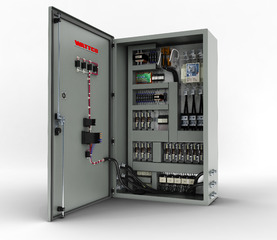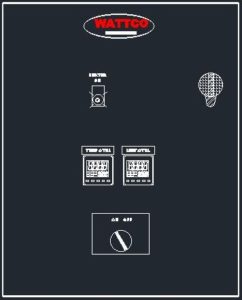Improving Control Panel Design for Heater Systems
Last updated on July 29th, 2021 at 03:30 pm
 Control panels are responsible for ensuring that industrial heating systems function properly, safely, and efficiently. They monitor temperatures, manage ideal heat transfer, and prevent overheating and chemical disintegration. Having the right controller not only keeps your processes running smoothly, but can even reduce operational costs.
Control panels are responsible for ensuring that industrial heating systems function properly, safely, and efficiently. They monitor temperatures, manage ideal heat transfer, and prevent overheating and chemical disintegration. Having the right controller not only keeps your processes running smoothly, but can even reduce operational costs.
The importance of, and reliance on, controllers has made constant digital control panel improvements and innovations among Watcco’s key focuses. This article explores some of the design guidelines Wattco follows and what to look for when choosing a control panel.
Control Panel Design Guidelines
Standardization
To optimize performance and reduce operational complications, it’s generally best to minimize the number of different manufacturers in one system. Try to have as much designed in one place as possible for the sake of compatibility. This ensures that all the parts function together as intended and all the connections, sizes, and wattages are in-sync.
An ideal industrial heater system uses a control panel, heater, as well as monitoring and safety devices that all come from one source. This reduces hiccups, increasing performance and reliability.
Design for a Specific Use
 As with shopping for electric heaters, the purchase and design of a control panel should be done with the specific project it is being used for in mind. Choosing a panel and then installing or retrofitting it to fit a project will not provide the same level of performance as designing the panel specifically for the project.
As with shopping for electric heaters, the purchase and design of a control panel should be done with the specific project it is being used for in mind. Choosing a panel and then installing or retrofitting it to fit a project will not provide the same level of performance as designing the panel specifically for the project.
Consider factors like temperature controls, fuel-air ratio control, safety limits, and other needs. Choose the functions and hardware that match those needs from the outset to maximize performance and synchronicity.
Simplify
An advanced, modern digital control panel shouldn’t be burdened with an overly complex design. The best designs are simple in both their background functions and user-facing sides. A simple backend design reduces issues and promotes ease of troubleshooting. At the same time, a simple interface provides a more friendly user-experience and decreases the learning curve.
A simple design is less likely to fail and promotes ease-of-use. The more parts and complications there are, the greater the possibility of integrated-device, communication, or user error.
Automation
Automation and remote monitoring are essential for any modern system. These prevent having to have someone onsite to monitor and run systems. An automated control panel monitors and manages operations faster and more efficiently, with no risk of human error. While this is beneficial for improving operational efficiency and decreasing costs, it is especially valuable for safety. An automated control panel automatically shuts down when safety functions are triggered, preventing hazards that can risk combustion or damage to products.
Automation makes all processes faster and more reliable while requiring less manpower and fewer expenses to operate.
Test
Finally, any new system requires adequate testing and monitoring. Pairing testing with experience from manufacturers like Wattco helps to ensure control panels function as expected under regular and emergency conditions.
Custom Control Panel Quotes
Wattco custom-manufactures electric heating equipment and control panels. Our team of experts can help you select the ideal configuration, settings, and equipment to match your specific project and budget.
Contact us today for digital control panel quotes and information.
